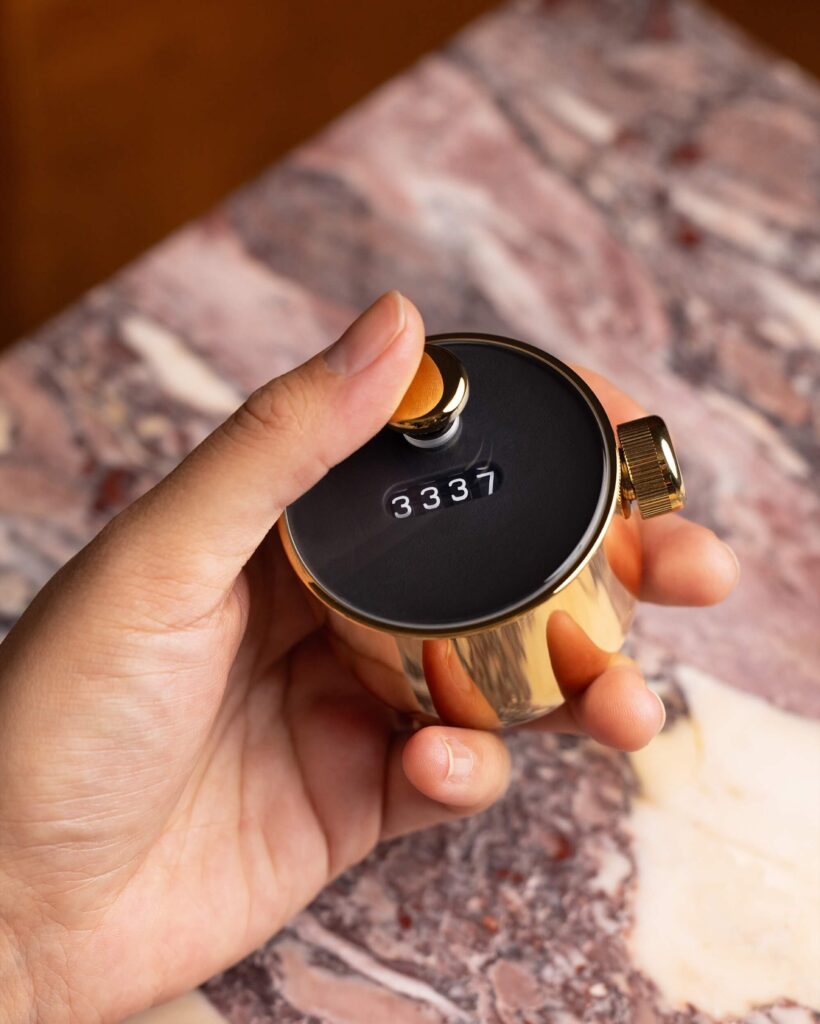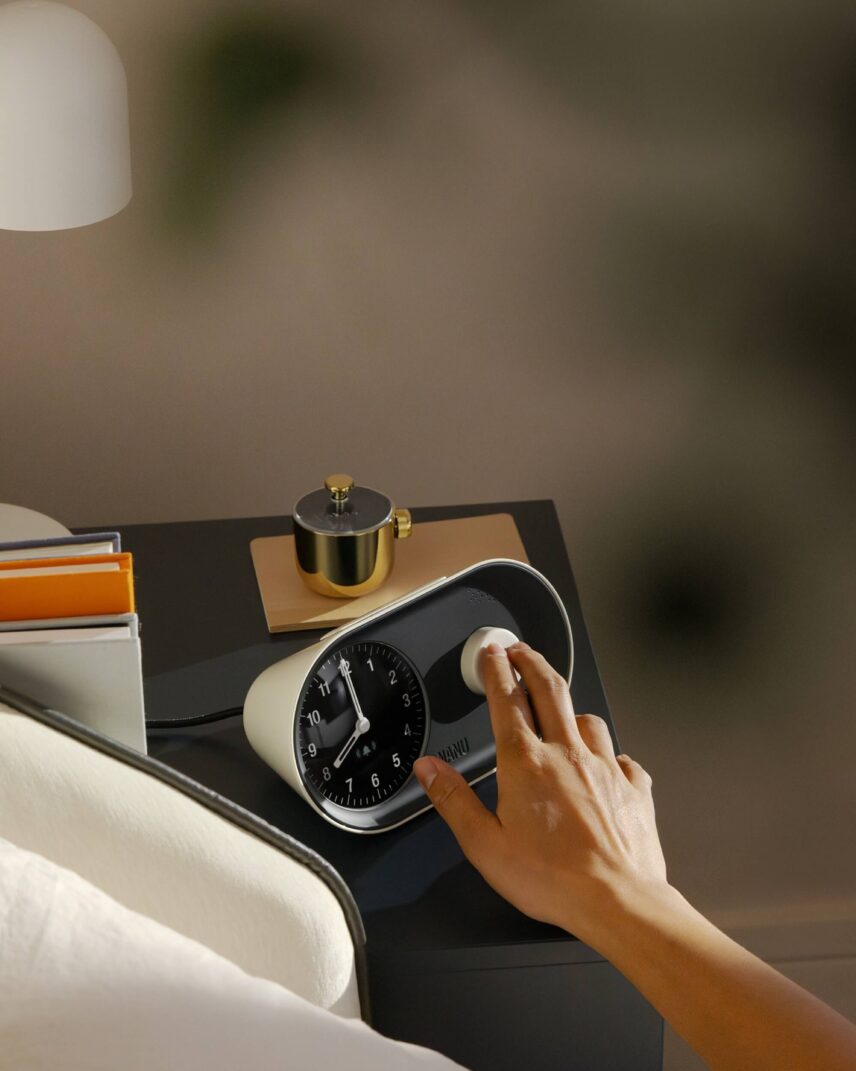This story originally appeared on the Gents Cafe Newsletter. You can subscribe here.
The beginning and end of the day are moments in which our body transitions from activity to sleep and vice-versa. We are meant to live them with intention, tributing the right importance to relaxing for the night or quietly starting a new day. However, more often than not, technological devices — especially smartphones — disrupt our balance and perception of time.
For Hanna McPhee and Drew Cosgarea, co-founders of Nanu, this realization sparked a mission: to make time feel real again. Drawing inspiration from personal experience, family heritage, and a fascination with traditional mechanics, they’ve created objects that bring presence to the everyday. Whether it’s the chime of an alarm clock, or the keeping track of milestones on a counter, Nanu invites people to reclaim their hours, rituals, and focus.
In this Brand Talks interview, Hanna and Drew open up about the origins of Nanu, the breakthroughs and challenges that shaped their products, and their vision for a slower, more intentional approach to time.

You describe Nanu as making “time feel tangible.” What personal experiences first convinced you that time deserves a physical interface?
The idea really started during COVID. Drew (my co-founder and husband) and I were both working remotely for a consumer design company called Fellow. They make modern coffee equipment, and they grew like crazy during the pandemic because everyone was making coffee at home. It was exciting, but it also meant we suddenly went from 0–100 in workload. We were on Zoom from about 8 a.m. to 10 p.m. most days, quarantining in a tiny San Francisco studio apartment, both working off the one small table we had.
On top of that, I had a really unhealthy relationship with Twitter at the time. There was just so much happening on the platform for brands, and I was glued to it — literally sleeping with my phone under my pillow and checking the news multiple times a night. Time started to feel like this blurry, endless stream of tech consumption. We weren’t really living in it — we were just being carried through it.
And I think a lot of people had a version of that realization globally during COVID. Whether you suddenly gained time because you weren’t commuting, or you lost your sense of time because you never left your house, everybody became hyper-aware of it. For us, that was the moment we started asking: “What if time could feel physical again? What if we could see ourselves spending it?”
The simplest modern example I give now is looking down to reply to a text and then looking up 20 minutes later without knowing where the time went. Your phone just quietly dissolves your hours. You end up with that familiar feeling of, “Where did the time go?” — and we wanted to create the opposite sensation. We wanted people to feel how they were spending time, so they could take ownership of it again.
The first practical step for us was realizing our phone had to get out of the bedroom. So we started hunting for alarm clocks. The modern ones were all digital and app-connected — which defeated the purpose — and the vintage ones were charming but often loud, unreliable, or inconvenient to set. We wanted something in between: a modern clock with the ease of use of today’s products, but the analog soul and presence of the old ones.
That became the seed for the Arc. It took two years to bring to life, but the original spark really came from those nights of me literally sleeping with my phone under my pillow — and realizing I needed a different relationship with time altogether.
Nanu is a play on Nannu, a Sicilian way of saying grandfather. How and why did you choose this name for your brand, and what does it represent to you personally?
I’m Italian American — my mom’s side of the family is from Puglia and Sicily — and the Sicilian side was definitely the dominant cultural influence growing up. Big extended family, loud kitchens, a thousand aunts and uncles in upstate New York — just that very classic Italian American upbringing.
We chose “Nanu” as a nod to Nannu, which is Sicilian for grandfather, because of the connection to grandfather clocks. Historically, clocks moved from being public into the home through the “grandfather clock”, then into smaller household clocks like cuckoo clocks, which is when people first started to have a personal relationship with time. So the name taps into that legacy: the idea of time as something you live with, not just something abstract on a screen.
There’s also a philosophical layer — so much of what we’re building is intentionally “older” in spirit. We want products that last decades, not product cycles. We lean into old-school design decisions that a typical tech company would never bother with. But at the same time, we’re not anti-modern. The Arc has a hidden digital display, there’s smart logic behind the mechanics — we understand that people live modern lives and convenience matters.
So much of what we’re building is intentionally “older” in spirit. We want products that last decades, not product cycles.
Nanu currently offers two products: the Arc Alarm Clock and the Nudge Counter. Could you introduce them to our readers and explain how they reflect your vision of rethinking our relationship with time?
With everything we make, we’re trying to give time a physical presence again — to improve small daily rituals in a way that feels grounding and a little less tech-dependent.
The Nudge was actually our first product to launch, even though the Arc was the original idea. The Nudge is a solid brass mechanical counter — you press the button to count up, and there’s a little reset knob to start over. It’s incredibly simple, but it has a really heartfelt origin. Both of us have family members who have struggled with sobriety, and mechanical counters are sometimes used in therapy to help people track impulses or cravings. The idea is: the moment you feel the urge — to drink, to smoke, even to bite your nails — you click the counter. You pause and ask yourself why that feeling surfaced. Was it stress? Tiredness? Anger? The first step to breaking a pattern is understanding the trigger.
Originally, we were only going to make 100 of them as a small passion project while the Arc was still deep in development. We launched it for Kickstarter’s “Make 100” campaign (even though we technically missed the January deadline and released it in March). But it resonated way beyond what we expected. People weren’t just using it for sobriety — they started using it to track milestones, gratitude, workouts, days of consistency, little wins. So now we call it a milestone counter, because that’s really what it’s become: a beautiful object that helps celebrate something meaningful, in a way a $5 plastic clicker never could.
The Arc, on the other hand, was always meant to be our flagship — the alarm clock that rethinks your relationship with waking up and winding down. From the very first prototype we knew we wanted a mechanical chime, which is rare and incredibly difficult (and expensive) to engineer today. But it mattered to us, because waking up to a beautiful analog sound just hits completely differently than a ringtone or a phone notification. The whole philosophy behind the Arc is that time shouldn’t be mediated through the same device that delivers your email, your doomscrolling, and your dopamine hits. It should have its own presence and its own ritual.

The way we start and end our day shapes everything in between. How can the Arc Alarm Clock help us start and finish our day with greater intention?
There’s a lot of research about why your phone shouldn’t be the first and last thing you interact with — and not just because of blue light. What most people don’t realize is that your phone is basically a hormone casino. The moment you open an email late at night, you can spike cortisol because your brain suddenly goes into “work mode.” On the flipside, scrolling social or playing a quick mobile game hits you with dopamine. Those artificial spikes at the wrong time of the day disrupt your natural rhythms — the timing of when your brain expects to feel alert or relaxed.
So the Arc is designed to replace that moment. It’s meant to live on your nightstand as the first thing you see in the morning and the last thing you see at night — which is actually where the name comes from: the “arc” of your day. It’s a small shift, but removing that portal to news, email, and distraction creates a psychological boundary. You wake up more gently. You wind down more cleanly. And it’s easier to feel like you’re beginning and ending the day on your own terms, instead of on your phone’s terms.
Your products are premium versions of common use objects that are often available for a fraction of the price, yet proved to be extremely successful. How do you explain this?
I think there are two main reasons. The first is that both products came from something really personal — not from a market gap or a trend analysis, but from lived experience. The Nudge came from watching family members work through sobriety, and the Arc came from our own struggles with tech addiction and mental health during COVID. We didn’t design “for everyone”; we designed for a very real, very specific need. Ironically, going that specific is what ended up resonating with so many people. Instead of trying to be a master-of-none mass-market product, we built something honest and intentional, and people can feel that.
The second reason is quality — which is sadly rare today. The Nudge is a solid block of brass with a lifetime warranty. The Arc is two and a half pounds of die-cast, machined metal with a 10-year warranty. They’re built like heirloom objects, not disposables. They’re repairable. They’re meant to stay in your life for decades, not until the next software update. I think there’s a growing fatigue around flimsy, mediocre products. When people finally come across something that feels substantial, thoughtful, and built to last, they talk about it and they want it in their homes.

What are some of the most unexpected or inspiring ways you’ve seen people use the Nudge Counter?
That’s such a fun question because the range is huge. The one that surprised us most is knitting — a lot of knitters use the Nudge to count stitches or rows when they’re working on blankets or big projects. It actually makes perfect sense when you think about it: knitters are already people who are intentionally off their phones and doing something slow and meditative with their hands, so they’re kind of our ideal user.
We’ve also seen really moving, health-related uses. Some people use it to track days in remission after chemotherapy, or even days battling cancer. That one in particular has been incredibly emotional to hear about — it reframed the counter for us as something deeply personal, not just functional.
Other people use it for positive habit tracking: miles run while training for a marathon, number of books read in a year, progress on personal challenges. And of course, sobriety is still a major use case — it’s actually where the Nudge originally came from. We also recently partnered with a nonprofit working to treat hepatitis C in the U.S., and they use the counter to track the number of cases they’ve helped cure.
What’s been really beautiful is realizing that people use it to mark meaningful progress, using it as a ritual. It’s a way of saying “this matters,” whether that’s healing, discipline, celebration, or survival.
Nanu’s products are designed for longevity and sustainability, embracing the Right to Repair movement. How does this design philosophy challenge today’s fast-consumption culture, and what opportunities do you see in building products meant to last?
Honestly, it’s really hard. It feels almost every day like we’re pushing uphill against the way the entire consumer hardware system is built. Most hardware companies are financed on the idea of recurring revenue — products that wear out so you buy another one. We’ve even had a potential investor ask us point-blank why we’d make something that lasts ten years, because then “won’t you lose the repeat purchase?” And my answer is: if you buy another thing from us, I want it to be because you want something new we’ve created — not because the first one failed you.
I don’t think the throwaway model works as well as people assume. There are great examples like Patagonia that prove you can build long-term loyalty by standing behind your products and repairing them. When you genuinely wow someone with quality — and then, if something does go wrong, you fix it — that person usually becomes a customer for life.
There are two really big opportunities here. The first is trust. A lot of our reviews literally say things like, “Whatever you make next, I’m buying.” That’s the outcome of putting so much care into material quality and repairability. It feels rare now, so people notice.
The second is word of mouth. We rely much more on that than on ads. You’re not going to tell ten friends about a cheap product that “gets the job done.” But if something feels substantial, lasts, and then the company repairs it when needed — that becomes a story people want to tell. And even the repair moment itself becomes a positive touchpoint, because most people have never had a consumer electronics company treat them that way.
There’s also a sustainability piece: when something is repairable, manufacturing defects don’t automatically become landfill. You can rework a unit, resell it, or refurbish it. That saves waste and cost at the same time.
When you genuinely wow someone with quality — and then, if something does go wrong, you fix it — that person usually becomes a customer for life.
Was there a moment during the design process—perhaps a failure, a breakthrough, or even a small detail—that particularly shaped the final identity of your products?
There was a huge breakthrough moment early on. Deep in the middle of COVID, when we were hunting for an alarm clock that actually felt good to wake up to, we started collecting vintage clocks. One day Drew bought this old Soviet-era mantle clock off eBay — it literally has a USSR stamp on the back. He took it apart, kept the mechanical chime, wired it to an Arduino, and basically Frankenstein-ed it into a prototype alarm clock that would chime at 8 a.m.
Until that point, we thought it would be beautiful to wake up to a real chime, but the only reference most people have are those twin-bell metal alarm clocks that just scream at you. This was the first time we actually experienced what it was like to wake up to a slow, resonant mechanical chime — and it was incredible. The sound was calming, grounded, and so much more human than a ringtone or buzzer.
That morning was when the design went from theory to conviction. It proved to us that the feeling we were chasing was real — that there was something emotionally meaningful about bringing analog mechanics back into a modern routine. It shaped the entire identity of the Arc, because from that point forward, the mechanical chime was the soul of the product.

Beyond clocks and counters, where do you imagine the philosophy of Nanu could go next? Are there other rituals of daily life you would like to redesign?
This is actually a big debate right now, because once you start thinking about “time” as something tangible instead of abstract, there are so many directions you can go. One path is routine — looking at different parts of the day where people instinctively reach for tech and asking, how do we pull them back into something more grounded? The other path is going deeper into timekeeping itself, because there are almost no true clock manufacturers left. A lot of people abandoned clocks once phones took over, but we’re hearing more and more that people miss experiencing time in a more physical, sensory way.
A great example is the number of customers who have asked for a “mantle mode” on the Arc — not as an alarm, but as a daily chime, like a modern digital-meets-mechanical mantle clock. That instinct from customers is really interesting, because it shows people want time to live in their environment again, not just on a screen.
We’ve also talked about calendars because there are so many different scales of time you can design for: the day, the week, the month, the year, or even multi-year cycles. And you can definitely take inspiration from the watch world, where people are totally willing to invest in beautiful timepieces even though they already have the time on their phone. They value the emotional and tactile connection to the mechanism.
The big question for us is where we want to land in that space — because a grandfather clock, for example, is extremely complex and expensive to make (and now that we’re in this industry, I fully understand why the few companies that still make them charge what they do). A calendar or smaller time object, on the other hand, would be much more accessible.
We also have to think about pace. In a perfect world, we’d launch a new product every year — but the level of quality we hold ourselves to, plus our size and resources, makes it more like every two years. And honestly, I think that’s okay. We’d rather make something repairable and extraordinary than release something “good enough” just to keep up with a seasonal product cycle.

Your stated mission is to help people cultivate a healthier relationship with time—whether reflecting on the past, staying present, or planning for the future. How would you describe your own relationship with time, both personally and professionally?
I think our relationship with time has definitely improved in some ways, though there are still areas where it could get better. For example, we both have an Arc on our nightstands, and cell phones aren’t allowed in the bedroom anymore. That’s been a game-changer for sleep. I’m a very light sleeper, and even small stresses used to disrupt me, but having the Arc has helped turn our bedroom into a more sacred, restful space. It’s really changed how we approach our mornings and evenings.
We both use the Nudge Counter too — sometimes for small things, like cutting back on candy for the month, and sometimes for more serious goals, like staying sober for a quarter. It’s helped us be more conscious about how we spend our time and track meaningful milestones.
That said, being founders of a hardware company means our relationship with work is still intense. Building a consumer hardware business is all-consuming, so while I’d say we’ve improved thanks to our own products, we’re still navigating challenges like work-life balance. If I had to grade it, I’d probably give us a B-minus: better than before, but still a lot of room to grow.









